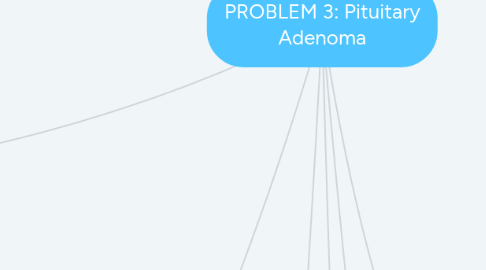
1. GHRH
2. Physiology
2.1. Covered
2.1.1. Growth Hormone
2.1.1.1. Causes
2.1.1.1.1. Increased Growth
2.1.1.1.2. Fat Utilization
2.1.1.1.3. Protein Anabolism
2.1.1.1.4. Decreased Glucose Uptake
2.1.1.2. Produces
2.1.1.2.1. Somatomedins
2.1.1.3. Regulated By
2.1.1.3.1. - Hyperglycemia
2.1.1.3.2. - Protein (Chronic)
2.1.1.3.3. Feedback
2.1.2. Anti-diuretic Hormone
2.1.2.1. Responds To
2.1.2.1.1. Increased Serum Osmolarity
2.1.2.1.2. Decreased ECF Volume
3. Management of Pituitary Adenoma
3.1. Pharmacotherapy
3.1.1. Classes
3.1.1.1. Somatostatin Analogues
3.1.1.2. GHR Antagonist
3.1.1.3. Dopamine Agonists
3.2. Radiological
3.2.1. Divide into
3.2.1.1. Stereotactic RadioSurgery (SRS)
3.2.1.1.1. Delivery
3.2.1.2. Fractionated Radiation Therapy (SRT)
3.2.1.2.1. Delivery
3.2.2. Choice depend on
3.2.2.1. Convenience
3.2.2.2. Safety
3.2.2.3. Therapeutic response
3.3. Surgical
3.3.1. Trans-Sphenoidal Surgery
4. Anatomy
4.1. includes
4.1.1. Pituitary gland
4.1.1.1. is a
4.1.1.1.1. Master gland
4.1.1.1.2. Circumventricular organ
4.1.2. anatomical relation
4.1.2.1. such as
4.1.2.1.1. anteriorly
4.1.2.1.2. posteriorly
4.1.2.1.3. superiorly
4.1.2.1.4. inferiorly
4.1.2.1.5. laterally
4.1.3. consist of
4.1.3.1. anterior lobe
4.1.3.1.1. can be divided into
4.1.3.2. posterior lobe
4.1.3.2.1. can be divided into
4.1.4. develops from
4.1.4.1. anterior lobe
4.1.4.1.1. Rathke's pouch
4.1.4.2. posterior lobe
4.1.4.2.1. forebrain
5. Physical examination
5.1. Inspection
5.1.1. Fatigue or lethargy
5.1.2. Weight gain or loss
5.1.3. Dizziness
5.2. Face and neck
5.2.1. Face
5.2.1.1. Cushing syndrome
5.2.1.1.1. Moon facies
5.2.1.1.2. Acne&Hirsutism
5.2.1.2. Hypothyrodism
5.2.1.2.1. Thinning of hair or eyebrows
5.2.1.3. Acromegaly
5.2.1.3.1. Prognathism
5.2.2. eyes
5.2.2.1. Periorbital puffiness (Hypothyroidism)
5.2.2.2. Graves disease
5.2.2.2.1. Exophthalmos
5.2.2.2.2. Lid retraction+ Lid rag
5.2.3. Mouth
5.2.3.1. Hypocortisolism
5.2.3.1.1. Pigmentation on buccal surfaces
5.2.3.2. Acromegaly
5.2.3.2.1. Tongue enlargement
5.2.4. Neck
5.2.4.1. Cushing's syndrome
5.2.4.1.1. Buffalo hump
5.2.4.2. Diabetes Mellitus
5.2.4.2.1. Hyperpigmentation in the neck or axillae
5.3. Chest and abdomen
5.3.1. Chest
5.3.1.1. Panhypopituitarism
5.3.1.1.1. Reduced female breast size
5.3.1.2. Adenomas (Hyper)
5.3.1.2.1. Milk production
5.3.1.3. Cushing's syndrome
5.3.1.3.1. Male gynecomastia
5.3.1.3.2. Central obesity
5.3.1.4. Hyperthyroidism
5.3.1.4.1. o Loud snapping first heart sounds in hyperthyroidism
5.3.1.4.2. o Flow murmurs in hyperthyroidism
5.4. Lower limbs
5.4.1. Skin temperature
5.4.2. Color
5.4.3. Hair distribution
5.5. Special tests
5.5.1. Ophthalmic Examination
5.5.2. Neurological Examination
6. Clinical Features
6.1. Manifest as
6.1.1. Syndrome of Hyper/Hypo- secretion
6.1.1.1. Such as
6.1.1.1.1. Acromegaly
6.1.2. Neurological Manifestations
6.1.2.1. Could Be
6.1.2.1.1. Visual Field Defect
6.1.2.1.2. Decreased Visual Acuity
6.1.3. Incidental Finding
6.1.3.1. Due To
6.1.3.1.1. Increased Usage of Sensitive Scans
7. Pituitary conditions
7.1. classified into
7.1.1. Anterior pituitary
7.1.1.1. Adenomas
7.1.1.1.1. Functional adenoma
7.1.1.1.2. Non functional
7.1.1.2. Hypopituitarism
7.1.2. Posterior pituitary
7.1.2.1. could be
7.1.2.1.1. Diabetes insipidus
8. Investigations
8.1. include
8.1.1. test pituitary hormones levels
8.1.1.1. Hyperpituitarism
8.1.1.1.1. may indicate
8.1.1.2. hypopituitarism
8.1.1.2.1. may indicate
8.1.2. hormones secreted by glands stimulated by pituitary
8.1.3. stimulation or suppression test
8.1.4. Imaging
8.1.4.1. MRI
8.1.4.2. CT

